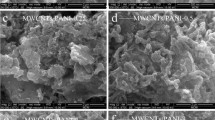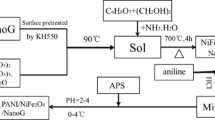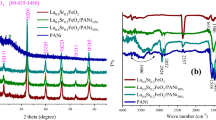Abstract
This study investigates the microwave absorption properties of polyaniline (PAni) with varying carbonaceous material, CM (Fullerene,C60) contents. PAni nanocomposites were prepared with varying contents of C60 ranging from 5 to 40% through a chemical oxidation method by using carboxylic acid as the dopant. The functional groups of PAni nanocomposites were validated by Fourier Transform Infrared Spectroscopy (FTIR) and Ultraviolet–visible (UV–Vis) Spectroscopy analyses. The surface morphology of nanocomposites and the presence of titanium dioxide (TiO2) and C60 were confirmed by Field Emission Scanning Electron Microscopy (FESEM) and X-ray Diffractometry (XRD), respectively. Microwave absorption studies were carried out using Microwave Vector Network Analyzer (MVNA) from 0.5 to 18.0 GHz. The study showed that PAni nanocomposites with 10% of C60 formed the nanorods/nanotubes with the biggest diameter of 200 nm as compared to other PAni nanocomposites. It was found that PAni nanocomposites with 10% C60 also recorded the highest electrical conductivity and relative permittivity of 1.708 × 10–1 S/cm and 9.97, respectively. The nanocomposite that was formulated with 10% of C60 showed an improvement of interchain and intrachain charge transfer as well as molecular polarization along the PAni backbone. Hence, it eventually reduces the electrical energy dissipated by PAni, and finally enhances the microwave absorption properties with the highest reflection loss (RL) of −61.3 dB at 9 GHz.









Similar content being viewed by others
References
Yang Z, Peng H, Wang W, Liu T (2010) Crystallization behavior of poly(ε-caprolactone)/layered double hydroxide nanocomposites. J Appl Polym Sci 116:2658–2667. https://doi.org/10.1002/app
Zhang L, Bi S, Liu M (2020) Lightweight electromagnetic interference shielding materials and their mechanisms. Electromagn Mater Devices. https://doi.org/10.5772/intechopen.82270
Xia X, Wang Y, Zhong Z, Weng GJ (2016) A theory of electrical conductivity, dielectric constant, and electromagnetic interference shielding for lightweight graphene composite foams. J Appl Phys. https://doi.org/10.1063/1.4961401
Kumar P, Narayan Maiti U, Sikdar A et al (2019) Recent advances in polymer and polymer composites for electromagnetic interference shielding: review and future prospects. Polym Rev. https://doi.org/10.1080/15583724.2019.1625058
Oh HJ, Dao VD, Choi HS (2018) Electromagnetic shielding effectiveness of a thin silver layer deposited onto PET film via atmospheric pressure plasma reduction. Appl Surf Sci 435:7–15. https://doi.org/10.1016/j.apsusc.2017.11.043
Singh R, Kulkarni SG (2014) Nanocomposites based on transition metal oxides in polyvinyl alcohol for EMI shielding application. Polym Bull 71:497–513. https://doi.org/10.1007/s00289-013-1073-2
Chung DDL (2000) Materials for electromagnetic interference shielding. J Mater Eng Perform 9:350–354
Jing X, Wang Y, Zhang B (2005) Electrical conductivity and electromagnetic interference shielding of polyaniline/polyacrylate composite coatings. J Appl Polym Sci 98:2149–2156. https://doi.org/10.1002/app.22387
Belaabed B, Wojkiewicz JL, Lamouri S et al (2012) Synthesis and characterization of hybrid conducting composites based on polyaniline/magnetite fillers with improved microwave absorption properties. J Alloys Compd 527:137–144. https://doi.org/10.1016/j.jallcom.2012.02.179
Pandey S, Ramontja J (2016) Rapid, facile microwave-assisted synthesis of xanthan gum grafted polyaniline for chemical sensor. Int J Biol Macromol 89:89–98. https://doi.org/10.1016/j.ijbiomac.2016.04.055
Georgakilas V, Perman JA, Tucek J, Zboril R (2015) Broad family of carbon nanoallotropes: classification, chemistry, and applications of fullerenes, carbon dots, nanotubes, graphene, nanodiamonds, and combined superstructures. Chem Rev 115:4744–4822. https://doi.org/10.1021/cr500304f
Mitra M, Kulsi C, Chatterjee K et al (2015) Reduced graphene oxide-polyaniline composites: synthesis, characterization and optimization for thermoelectric applications. RSC Adv 5:31039–31048. https://doi.org/10.1039/c5ra01794g
Chen T, Qiu J, Zhu K, Li J (2016) Electro-mechanical performance of polyurethane dielectric elastomer flexible micro-actuator composite modified with titanium dioxide-graphene hybrid fillers. Mater Des 90:1069–1076. https://doi.org/10.1016/j.matdes.2015.11.068
Mo TC, Wang HW, Chen SY, Yeh YC (2008) Synthesis and dielectric properties of polyaniline/titanium dioxide nanocomposites. Ceram Int 34:1767–1771. https://doi.org/10.1016/j.ceramint.2007.06.002
Phang SW, Kuramoto N (2008) Development and investigation of polyaniline micro/nanocomposites that possess moderate conductivity, dielectric and magnetic properties. Polym J 40:25–32. https://doi.org/10.1295/polymj.PJ2007049
Kumar A, Kumar V, Awasthi K (2018) Polyaniline–carbon nanotube composites: preparation methods, properties, and applications. Polym Plast Technol Eng 57:70–97. https://doi.org/10.1080/03602559.2017.1300817
Youssef Z, Vanderesse R, Colombeau L et al (2017) The application of titanium dioxide, zinc oxide, fullerene, and graphene nanoparticles in photodynamic therapy. Cancer Nanotechnol. https://doi.org/10.1186/s12645-017-0032-2
Nguyen VH, Lamiel C, Kharismadewi D et al (2015) Covalently bonded reduced graphene oxide/polyaniline composite for electrochemical sensors and capacitors. J Electroanal Chem 758:148–155. https://doi.org/10.1016/j.jelechem.2015.10.023
Sapurina I, Mokeev M, Lavrentev V et al (2000) Polyaniline complex with fullerene C60. Eur Polym J 36:2321–2326. https://doi.org/10.1016/S0014-3057(00)00012-4
Kang Y, Kim SK, Lee C (2004) Doping of polyaniline by thermal acid-base exchange reaction. Mater Sci Eng C 24:39–41. https://doi.org/10.1016/j.msec.2003.09.047
Giusca C, Baibarac M, Lefrant S et al (2002) C60-polymer nanocomposites: evidence for interface interaction. Carbon NY 40:1565–1574. https://doi.org/10.1016/S0008-6223(02)00024-6
Radoičić M, Šaponjić Z, Nedeljković J et al (2010) Self-assembled polyaniline nanotubes and nanoribbons/titanium dioxide nanocomposites. Synth Met 160:1325–1334. https://doi.org/10.1016/j.synthmet.2010.04.010
Xiong S, Yang F, Ding G et al (2012) Covalent bonding of polyaniline on fullerene: enhanced electrical, ionic conductivities and electrochromic performances. Electrochim Acta 67:194–200. https://doi.org/10.1016/j.electacta.2012.02.026
Wang Q, Wang S, Li J, Moriyama H (2012) Synthesis and characterization of C 60/polyaniline composites from interfacial polymerization. J Polym Sci B Polym Phys 50:1426–1432. https://doi.org/10.1002/polb.23142
Saini P, Choudhary V, Singh BP et al (2009) Polyaniline-MWCNT nanocomposites for microwave absorption and EMI shielding. Mater Chem Phys 113:919–926. https://doi.org/10.1016/j.matchemphys.2008.08.065
Zhao B, Shao G, Fan B et al (2014) Effect of the TiO2 amounts on microwave absorption properties of Ni/TiO2 heterostructure composites. Phys B Condens Matter 454:120–125. https://doi.org/10.1016/j.physb.2014.07.079
Tavakolinia F, Yousefi M, Afghahi SSS et al (2020) Effect of polyaniline on magnetic and microwave absorption properties in SrFe12O19/Zn0.4Co0.2Ni0.4Fe2O4 ferrite nanocomposites. J Inorg Organomet Polym Mater. https://doi.org/10.1007/s10904-020-01547-0
Manna K, Srivastava SK (2017) Fe3O4@carbon@polyaniline trilaminar core-shell composites as superior microwave absorber in shielding of electromagnetic pollution. ACS Sustain Chem Eng 5:10710–10721. https://doi.org/10.1021/acssuschemeng.7b02682
Liu J, Duan Y, Song L, Zhang X (2018) Constructing sandwich-like polyaniline/graphene oxide composites with tunable conjugation length toward enhanced microwave absorption. Org Electron 63:175–183. https://doi.org/10.1016/j.orgel.2018.09.017
Acknowledgments
The authors would like to acknowledge the financial support from the UMRG (RG294-14AFR), PPP Grant (PG145-2014B) and thanks the Department of Chemistry, Faculty of Science, University of Malaya, Malaysia. The authors would also like to acknowledge Mr. Masato Tadokoro from The Yokohama Rubber Co., Ltd., Japan for his assistance in the microwave absorption measurements.
Author information
Authors and Affiliations
Corresponding author
Additional information
Publisher's Note
Springer Nature remains neutral with regard to jurisdictional claims in published maps and institutional affiliations.
Rights and permissions
About this article
Cite this article
Mokhtar, N., Wong, PY., Teh, GB. et al. Microwave absorption properties of polyaniline (PAni) with various amount of carbonaceous material (CM). Polym. Bull. 78, 6351–6365 (2021). https://doi.org/10.1007/s00289-020-03432-9
Received:
Revised:
Accepted:
Published:
Issue Date:
DOI: https://doi.org/10.1007/s00289-020-03432-9




